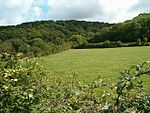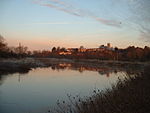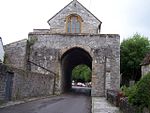Aller Hill

Aller Hill (grid reference ST408291) is an 18.4 hectare (45.4 acre) biological Site of Special Scientific Interest near Aller in Somerset, notified in 1988. The site contains three species of plant which are nationally rare and a further three which are of restricted distribution in Somerset. The central area contains a sward dominated by sheep's fescue (Festuca ovina) in combination with yellow oat grass (Trisetum flavescens) and quaking-grass (Briza media). Salad burnet (Sanguisorba minor) forms a major component of the sward with rough marsh-mallow (Althaea hirsuta) and nit-grass (Gastridium ventricosum), two nationally rare species, also present.Aller and Beer Woods on the slopes of the hill are also designated as a biological Site of Special Scientific Interest.
Excerpt from the Wikipedia article Aller Hill (License: CC BY-SA 3.0, Authors, Images).Aller Hill
Aller Hill,
Geographical coordinates (GPS) Address Nearby Places Show on map
Geographical coordinates (GPS)
| Latitude | Longitude |
|---|---|
| N 51.05817 ° | E -2.84608 ° |
Address
Aller Hill
Aller Hill
TA10 0DD , Aller
England, United Kingdom
Open on Google Maps










